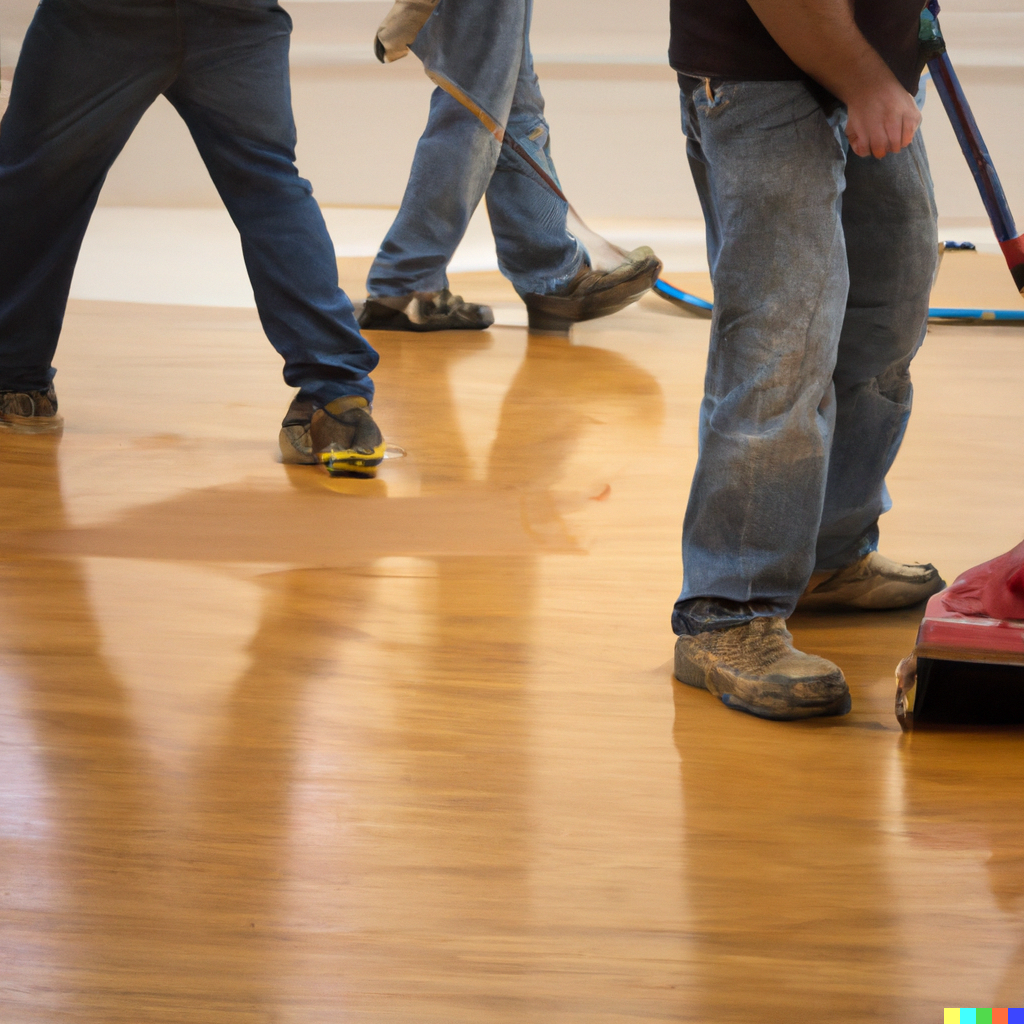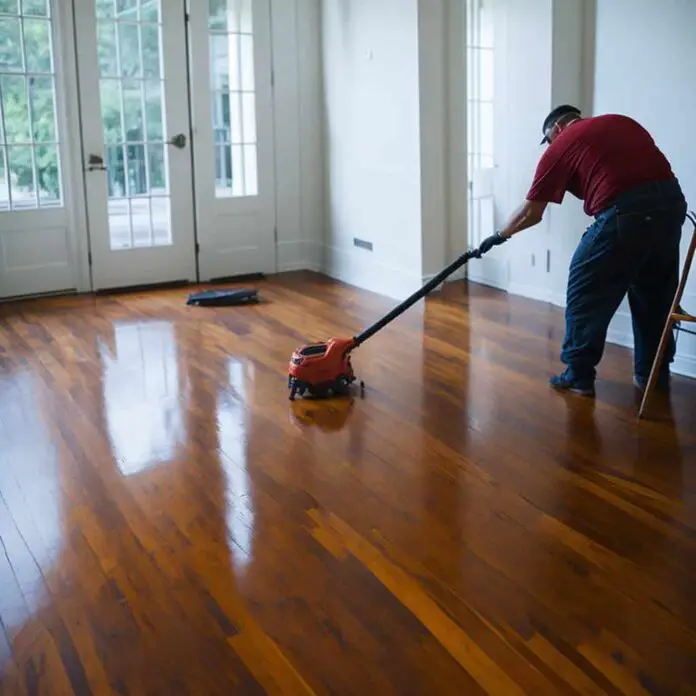Yes, you can stay in your house while your floors are being refinished.
However, it is important to keep in mind that there will be some disruption to your home during the refinishing process, and you may need to take some precautions to minimize exposure to fumes and dust. It is recommended to keep windows open for ventilation, and to avoid walking on the floors until they are completely dry. Additionally, it is best to move furniture out of the room being refinished to give the professionals room to maneuver without you having to deal with the inconveniences.
Table of Contents
Factors to consider if you can stay in the house while floors are refinished
Type of Floor Refinishing:
Sanding:
- Involves removing the top layer of the floor, creating dust and noise.
- Can be disruptive to your daily routine.
Staining:
- Involves applying a colored stain to change the floor’s appearance.
- Creates some dust and fumes but is generally less disruptive than sanding.
Polyurethane Application:
- A protective coating applied after sanding or staining.
- Can create fumes but is generally less disruptive than sanding.
Type of Finish:
Oil-Based Finish:
- Offers durability and a rich color.
- Emits more fumes and has a longer drying time.
Water-Based Finish:
- Less durable than oil-based finishes but dries faster and emits fewer fumes.
Size and Duration of the Project:
Project Size:
- The extent of the project affects the disruption to your daily life.
- Refinishing a single room is less disruptive than the entire house.
Project Duration:
- The time required for the project is a crucial consideration.
- Several days or weeks may be more challenging than a day or two.
Considering these points will help you make an informed decision about staying in your house during floor refinishing and how to minimize disruption to your routine.
Tips for staying in the house during floor refinishing

Clear Communication with the Contractor:
- Make sure you understand the scope of the project and what to expect during the refinishing process.
- Discuss any concerns you have with the contractor, such as allergies or health issues that may be affected by dust or fumes.
- Establish a timeline for the project and make sure you are aware of any changes to the schedule.
Preparing the House for the Work:
- Move all furniture and items out of the room or rooms being refinished.
- Cover any remaining items with plastic sheeting to protect them from dust and debris.
- Seal off the room or rooms being refinished with plastic sheeting to prevent dust and fumes from spreading to other areas of the house.
Minimizing the Impact of Dust and Fumes:
- Use a dust collection system to minimize the amount of dust created during sanding.
- Choose low VOC (volatile organic compound) finishes to minimize the amount of fumes emitted during the refinishing process.
- Keep windows and doors open to improve ventilation and reduce the concentration of fumes in the air.
Relocating Pets During the Work:
- Pets should be kept out of the house during the refinishing process to prevent them from inhaling dust and fumes.
- If it is not possible to relocate pets, they should be kept in a room as far away from the refinishing area as possible, with plenty of ventilation and fresh air.
By following these tips, you can stay in your house during floor refinishing while minimizing the disruption to your daily routine and ensuring your safety and health.
Alternatives to staying in the house during floor refinishing
Staying with Family or Friends:
- Staying with family or friends is often an affordable option for temporary housing during floor refinishing.
- Communicate with your hosts about the duration of your stay and any concerns related to allergies or health issues.
- Be respectful of your hosts’ space and follow any rules or guidelines they may have for guests.
Renting Temporary Housing:
- Temporary housing options include extended stay hotels, corporate housing, and short-term rentals through platforms like Airbnb or VRBO.
- Consider the location of the temporary housing in relation to your home and its impact on your daily routine.
- Research reviews and amenities provided by the temporary housing provider before making a reservation.
Direct Temporary Housing Assistance:
- In the event of a disaster, FEMA may offer direct temporary housing assistance to eligible homeowners or renters whose homes have been damaged or destroyed.
- Direct temporary housing options may involve leasing existing residential properties or providing other readily fabricated dwellings.
- Eligibility criteria and application processes vary based on the specific disaster and location.
By considering these alternatives, you can make an informed decision about the best option for your situation during floor refinishing. Prioritizing your safety and comfort is essential throughout the process.
What are some ways to minimize the impact of floor refinishing on daily life?
- Avoid foot traffic to keep the mess from spreading.
- Wear a respirator mask to prevent inhalation of dust and harmful chemicals during the entire process, especially during sanding and staining.
- Cover sensitive pieces with blankets or cloths, then place plastic over the top to protect them from dust.
- Thoroughly sweep and vacuum the flooring before refinishing. Follow up with a tack cloth to remove all the dust you can.
- Spotless the floor, ensuring it’s free from dust, debris, or any other particles that might hinder the sanding process.
- Move the furniture and pull up any carpeting or rugs in the room.
- Hammer down protruding nails before refinishing.
- Each time you’re ready to change grades on the drum sander, make sure you use the edger with the same grade sandpaper to keep the entire floor sanded at a uniform consistency.
- Use a dust collection system to minimize the amount of dust created during sanding.
- Choose low VOC (volatile organic compound) finishes to minimize the amount of fumes emitted during the refinishing process.
- Keep windows and doors open to improve ventilation and reduce the concentration of fumes in the air.
- Relocate pets during the work to prevent them from inhaling dust and fumes.
By following these tips, you can minimize the impact of floor refinishing on daily life and ensure a successful refinishing project.
How can you protect pets during floor refinishing?
Keep pets away from the work area:
- During the refinishing process, keep your pet as far away from the work area as possible.
- The chemicals and dust can be harmful to their health, so it’s best to keep them in a separate room or outside the house.
Trim pet nails:
- Regularly trim your pet’s nails to prevent scratches and scuffs on the newly refinished flooring.
- If you have a dog, daily walks can help naturally file their nails, keeping them dull rather than sharp and pointy.
Choose a lighter stain and avoid glossy finishes:
- Opt for a lighter stain to help conceal any minor damage your pet may cause.
- Avoid glossy finishes, as they tend to highlight scratches and dings. Satin or matte finishes are better at hiding imperfections.
Place carpet runners:
- Use carpet runners in high-traffic areas, such as entrances and areas where your pet likes to roam.
- Carpet runners can help hide damage that can’t be fixed without sanding down the floor, improving the floor’s appearance.
Wax and apply scratch-resistant coating:
- Apply a scratch-resistant coating to your floors to prevent damage from your pets.
- Waxing your floors can also provide an extra layer of protection against scratches and scuffs.
By following these tips, you can protect your pets during floor refinishing and ensure their safety and comfort throughout the process.
How long does it typically take to refinish hardwood floors?
- The average floor refinish time is 2 to 6 days.
- Contractors can typically sand about 1,500 to 2,000 square feet in one day.
- For a natural (no stain) sanding job with 2 coats of an oil-based polyurethane finish, the minimum time needed is 2 days. For 3 coats of oil-based poly, a minimum of 3 days is required.
- Allow at least two days for a “sand and poly” job, or three to seven days for a full refinishing project.
- Most wood floor refinishing projects are done on 1,000 to 1,500 square feet within one day.
- The exact time to refinish hardwood floors depends on various factors, including the type of finish, square footage, humidity, wood species, and home preparation.
- After refinishing, it may take 6-12 days before you can move furniture back into the house.
So, the time required for hardwood floor refinishing can vary, but the average falls within the range of 2 to 6 days. However, it’s essential to consult with a professional contractor to get a more accurate estimate based on your specific project’s details.
What is the cost of refinishing hardwood floors?
The cost of refinishing hardwood floors can indeed vary based on several factors. Here are the key points about the cost:
- Homeowners can expect to pay between $3 to $8 per square foot for refinishing hardwood floors.
- For a single bedroom, the cost may range from $300 to $800, while refinishing the entire home could cost between $2,400 and $6,000.
- Refinishing hardwood stairs tends to be more expensive, with an average cost of about $40 to $75 per stair tread.
- The cost of refinishing hardwood floors can be influenced by factors such as the local cost of labor, the complexity of the work, and the total size of the area to be refinished.
Conclusion
In conclusion, whether you can stay in your house while floors are being refinished depends on various factors, including the type of refinishing, the size of the project, and your tolerance for disruption. While it is possible to stay, taking precautions to minimize exposure to dust and fumes is crucial. Clear communication with the contractor, careful preparation, and following safety guidelines are essential for a successful refinishing experience. Consider alternatives if the project’s scale or duration makes staying at home impractical. By making informed decisions and prioritizing safety and comfort, you can successfully navigate floor refinishing in your home.

I don’t think the title of your article matches the content lol. Just kidding, mainly because I had some doubts after reading the article.
Your article helped me a lot, is there any more related content? Thanks!